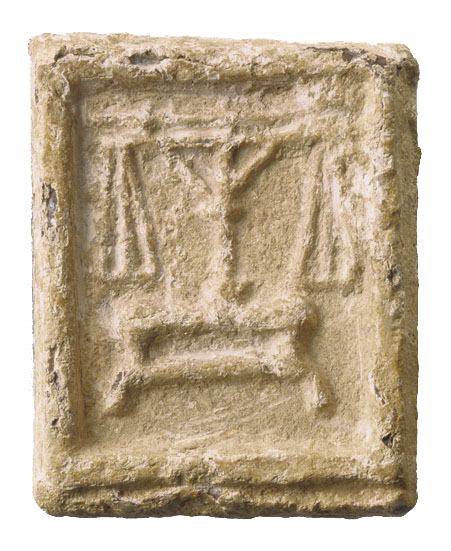
-
Copyright credit: J. Paul Getty Museum

-
Copyright credit: J. Paul Getty Museum

ARCHAEOLOGICAL DESCRIPTION OF THE WEIGHT
Authority
Mint
Denomination
1/4 Mina
Material
Lead
Manufacture
Cast
Shape
Square
Length
6.67 cm
(2.625 inch)
Width
5.56 cm
(2.1875 inch)
Height
1.11 cm
(0.4375 inch)
Metrology
| Mass (g) | Mass (grain) | Date of measurement | Reference | fragmented | cleaned | reference weight |
|---|---|---|---|---|---|---|
| 213.78 | 3299.1004 | - | www.getty.edu | No | No | Yes |
Iconography
| Symbol | Technique | Direction | Position | Number | Synecdoche |
|---|---|---|---|---|---|
| Balance scale | |||||
| Two-handled cup |
Wear
Corrosion
Handle
No
Suspension hole
No
Recarved mould
No
Recarved weight
No
Intentionally destroyed
No
Archaeological description
The image of a balance scale, called a libra by the Romans, decorates the front of this weight designed for use with just such an apparatus. The flat, plaque-like form of this object is typical for balance scale weights. The back of the weight depicts a footed, two-handled cup, probably a measure for grains or liquids. Scholars do not know what the two bell- or dome-shaped objects suspended above the cup represent. The use of images like the cup and scale on this object emphasize the importance of accurate measurement in the ancient world. The fairness of the weights and measures used by merchants was essential to the proper running of the economy. The weight of the piece is one quarter of a mina. Although the mina was a Greek weight unit, areas of the eastern Mediterranean region that were originally Greek but had by this time fallen under Roman rule often continued to use Greek standards.
Autopsy
No
INSCRIPTION
| Language | Technique | Legend type |
|---|
Fac simile
Edition
Monogram
ARCHAEOLOGICAL CONTEXT
Findspot (region)
Findspot (site)
context
CIRCUMSTANCES OF ACQUISITION
Region
City
Date of first acquisition
circumstances
Gift of Barbara and Lawrence Fleischman (New York, 1925 - New York, 1997) to the J. Paul Getty Museum in 1996. Sold to Barbara and Lawrence Fleischman in 1988, Fritz Bürki & Son (Zurich, Switzerland).
DATING OF THE WEIGHT
Curatorial Section
ROMAN
Time frame
Comments on Chronology
2nd century
COLLECTION HISTORY
Collection
| Name | Date of acquisition | Inventory number |
|---|---|---|
| Fleischman Collection | Jan. 1, 1988 | F11 |
| Getty Museum – Getty Villa (Malibu) | Jan. 1, 1996 | 96.AI.184 |
Bibliography
| Reference | Page/Column | Reference (number) | Plate / Figure | Comment |
|---|---|---|---|---|
| True and Hamma 1994 | 279 | 142 | ||
| Getty Museum 1997–98 | 69 |
VARIA
Additional comment
Roman weight, Eastern Mediterranean.
Permalink